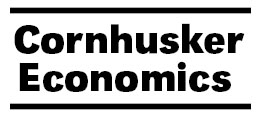Agricultural Economics, Department of

Cornhusker Economics
Date of this Version
2017
Document Type
Newsletter Issue
Citation
Cornhusker Economics, March 22, 2017, agecon.unl.edu/cornhuskereconomics
Abstract
Understanding the influence of variable rate nitrogen technology in other areas can help inform Nebraska producers. The economic cost of achieving desired environmental outcomes from uniform and variable rate fertilizer application technologies depends both on market forces and agronomic properties. Using spatial econometric methods, we analyze the impact of nitrogen fertilizer supply by terrain attribute on the yield and protein content of hard red spring wheat grown in Eastern Washington as well as the impact on residual nitrogen. We find significant association with all three. The economic impact of nitrogen restrictions depends critically on both prices and level of the restriction. Uniform application of nitrogen was found to economically outperform variable rate application, but variable rate application provided positive environmental benefits due to less residual nitrogen.


Comments
Copyright 2017 University of Nebraska